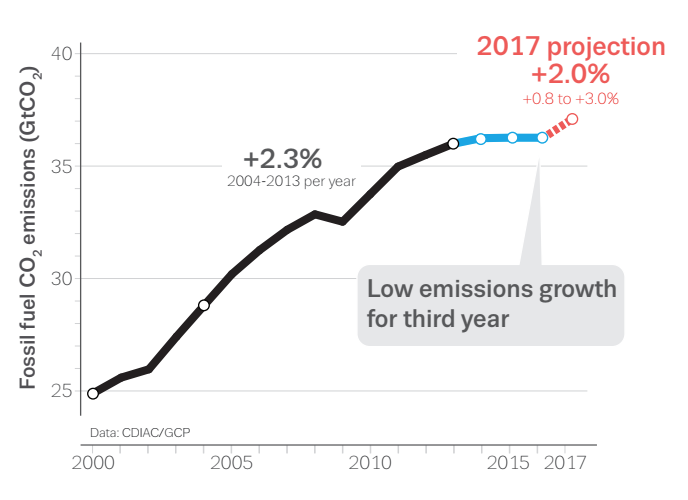China’s carbon emissions are projected to grow by 3.5% in 2017, ending a trend that has seen emissions plateau for the past three years globally, according to a new study launched at the UN climate talks in Bonn.
Although China has set ambitious targets to curb coal consumption and move toward a sustainable model of development, it continues to promote heavy industry as a means of boosting economic growth when GDP threatens to fall too fast.
The rise in China’s emissions is caused by greater coal consumption following fresh stimulus to infrastructure, concentrated in the steel and cement sectors, found the study by Global Carbon Project.
Another contributing factor was a decline in hydropower in 2017 caused by flooding and drought in southern China that required more coal power to be brought online. The country’s oil and gas sectors also grew strongly at 5% and 12%, respectively.
By the end of 2017, global emissions of carbon dioxide from fossil fuels and industry are projected to rise by about 2% compared with the preceding year, with an uncertainty range between 0.8% and 3%, found the report. The uptick follows three years of relatively flat emissions.
Glen Peters, research director at CICERO in Oslo and a co-author of the research, said:
“China emits about 30% of global emissions, and so what happens in China has a huge effect on global emissions. From an equity perspective, one could argue that more pressure should be put on countries like Australia, but unless China reduces its emissions, eventually to zero, we will never meet out climate objectives.”
Lauri Myllyvirta, East Asia energy analyst for Greenpeace, warned against drawing any long term conclusions from the spike in emissions.
“China’s increased emissions are expected to be temporary as economic stimulus cools and tough air pollution policies begin to impact. Its renewable energy sector also continued to grow at an astonishing rate,” he said.
The study found that renewables have been increasing at 14% per year over the past five years.
Overall, the amount of global emissions as a promotion of GDP continues to fall, as it has been since 2007. US emissions declined 0.4% in 2017 despite Trump’s policies; while India’s emissions are projected to grow by only 2% in 2017, down from 6% over the past decade.
Global carbon emissions on the rise

China still on track
Despite the rebound, China remains on track to peak its carbon emissions by 2030, as set out in the 13th Five-Year Plan for economic growth. However, analysts from the National Resources Defense Council and the Global Carbon Project think the country will peak its emissions sooner.
“Chinese emissions growth will be low in the next few years, reaching a plateau and a peak soon after. A peak is likely in the early 2020’s as economic growth slows, and climate policies continue. The peak could be earlier, but we really need a few years to see how emissions develop,” said Peters.
China’s government recently launched new measures to reduce the severity of winter air pollution, which has triggered a health crisis in the north of the country in the past two years. It plans to reduce levels of harmful particulates (PM2.5s) over by 15%.
“By reducing the use of coal for winter heating and having more oil and gas heating, we could see a downturn because of those goals,” said Alvin Lin, China climate and energy policy director with the Natural Resources Defense Council.
“The full effect of the winter package has not kicked in, so it’s fair to say that what we will get at the end of this year might be lower than 3.5% but we will still need to see. It looks like a lot of factories near Hebei, close to Beijing, have been shut down but then again enforcement and implementation are always a big problem in China,” said Li Shuo, senior climate and energy policy officer at Greenpeace China.
India and Europe
India’s emissions are projected to grow 2% in 2017, according to the report. This stands in contrast to sustained increases of over 6% per year during the past decade. While growth in coal consumption is similar to the previous two years at about 3%, oil consumption growth has stalled, at less than 1%, and cement production has dropped sharply, by more than 6% through to August.
In Europe, a decade-long trend of falling emissions will continue but at only by 0.2% in 2017. Emissions from Japan fell in 2016 after year of several or flat growth; the decline is due to increase solar energy and return to nuclear power after reducing output after Fukushima accident six years ago. While in Brazil emissions down largely due to the country’s economic crisis, found the report.









